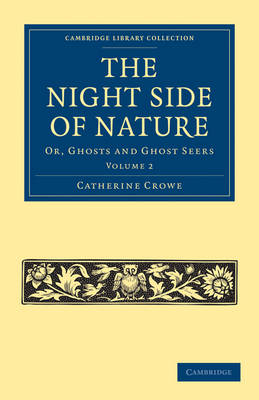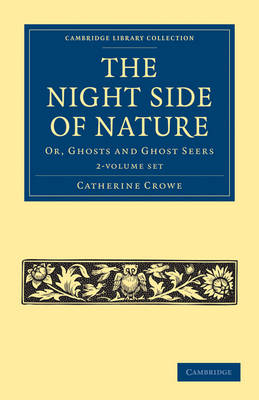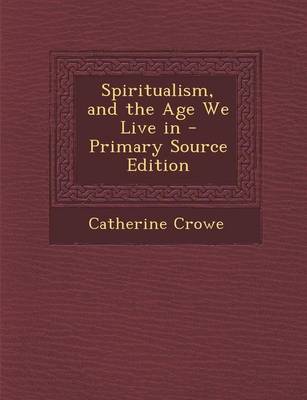Cambridge Library Collection - Spiritualism and Esoteric Knowledge
1 primary work • 6 total works
Volume 2
The novelist and children's author Catherine Crowe (c.1800–1876) published The Night Side of Nature in two volumes in 1848. This lively collection of ghostly sketches and anecdotes was a Victorian best-seller and Crowe's most popular work. Sixteen editions appeared in six years, and it was translated into several European languages. The stories are intertwined with Crowe's own interpretations and commentaries which attack the scepticism of enlightenment thought and orthodox religion. Crowe seeks instead to encourage and re-invigorate a sense of wonder and mystery in life by emphasising the supernatural. Volume 2 probes the mysterious phenomena of troubled spirits, haunted houses, spectral lights, apparitions and poltergeists. Crowe's vivid tales, written with great energy and imagination, are classic examples of nineteenth-century spiritualist writing and strongly influenced other authors, including Charles Baudelaire, as well as providing inspiration for later adherents of ghost-seeing and psychic culture.
The novelist and children's author Catherine Crowe (c.1800-1876) published The Night Side of Nature in two volumes in 1848. This lively collection of ghostly sketches and anecdotes was a Victorian best-seller and Crowe's most popular work. Sixteen editions appeared in six years, and it was translated into several European languages. The stories are intertwined with Crowe's own interpretations and commentaries which attack the scepticism of enlightenment thought and orthodox religion. Crowe seeks instead to encourage and re-invigorate a sense of wonder and mystery in life by emphasising the supernatural. The stories in Volume 1 centre on dreams, psychic presentiments, traces, wraiths, doppelgangers, apparitions, and imaginings of the after-life. Volume 2 probes the mysterious phenomena of troubled spirits, haunted houses, spectral lights, apparitions and poltergeists. Crowe's vivid tales, written with great energy and imagination, are classic examples of nineteenth-century spiritualist writing.
The Seeress of Prevorst
by Catherine Crowe and Justinus Andreas Christian Kerner
Published 9 January 2010
Friederike Hauffe (1801-1829) suffered throughout her short lifetime from severe spasms and nervous fevers, and in her semi-conscious state she allegedly saw spectres and spoke and wrote predictions in an unknown, 'innate' language. When physically well, Hauffe could communicate with spectres of the dead, and created a complex diagram of circles to explain the nervous energy of a person and its changes throughout the year. The flow of consciousness and one's waking state in the spirit world, or 'sun sphere', was individual and seasonal. After continued illness, she was finally taken into the care of Dr Justinus Kerner for the last few years of her life. His use of magnetic treatment apparently gave her some relief, and she was able to use her 'spiritual sight' to aid others. Kerner's 1829 account of her life, depicting a woman with unusual psychic gifts, was published in English translation in 1845.
Catherine Crowe (1790-1872) was a successful author of fiction, non-fiction and plays, who moved in literary circles and corresponded with the prominent authors of her day, including W. M. Thackeray and Harriet Martineau. Her interest in the supernatural and the spiritual dimension, and her frustration with the narrow-mindedness of her generation, are evident in this work, first published in 1859. A strong believer in the possibilities of spiritual planes and of forces beyond contemporary human knowledge, she suggests that much is still unknown to the human race, and that the advance of scientific materialism may hinder the search for spiritual insight. Unusually for her time, Crowe also questions the literal truth of the Bible, suggesting metaphorical interpretations of scripture, and asks how modern miracles or prophets might be recognised, in a society so closed to the possibility of the physically impossible.
The novelist and children's author Catherine Crowe (c.1800–1876) published The Night Side of Nature in two volumes in 1848. This lively collection of ghostly sketches and anecdotes was a Victorian best-seller and Crowe's most popular work. Sixteen editions appeared in six years, and it was translated into several European languages. The stories are intertwined with Crowe's own interpretations and commentaries which attack the scepticism of enlightenment thought and orthodox religion. Crowe seeks instead to encourage and re-invigorate a sense of wonder and mystery in life by emphasising the supernatural. Volume 2 probes the mysterious phenomena of troubled spirits, haunted houses, spectral lights, apparitions and poltergeists. Crowe's vivid tales, written with great energy and imagination, are classic examples of nineteenth-century spiritualist writing and strongly influenced other authors, including Charles Baudelaire, as well as providing inspiration for later adherents of ghost-seeing and psychic culture.
The novelist and children's author Catherine Crowe (c.1800–1876) published The Night Side of Nature in two volumes in 1848. This lively collection of ghostly sketches and anecdotes was a Victorian best-seller and Crowe's most popular work. Sixteen editions appeared in six years, and it was translated into several European languages. The stories are intertwined with Crowe's own interpretations and commentaries which attack the scepticism of enlightenment thought and orthodox religion. Crowe seeks instead to encourage and re-invigorate a sense of wonder and mystery in life by emphasising the supernatural. The stories in Volume 1 centre on dreams, psychic presentiments, traces, wraiths, doppelgängers, apparitions, and imaginings of the after-life. Crowe's vivid tales, written with great energy and imagination, are classic examples of nineteenth-century spiritualist writing and strongly influenced other authors as well as providing inspiration for later adherents of ghost-seeing and psychic culture.




